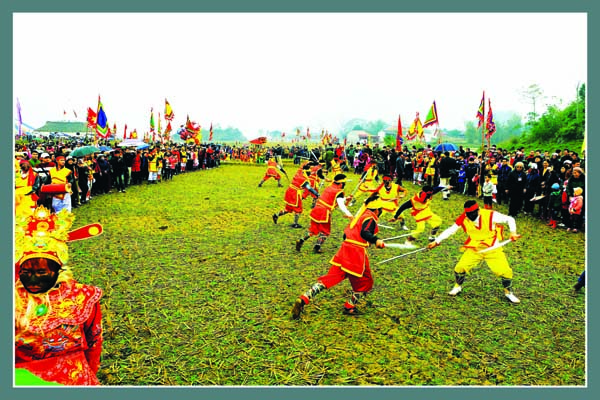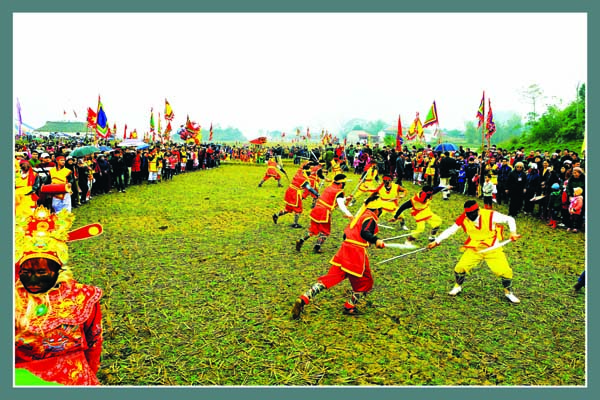(No.6, Vol.8,Dec 2018-Jan 2019 Vietnam Heritage Magazine)



There is an ancient tradition which was discontinued for 50 years, and restored completely in 2012 by ethnographers and local people. Since then, this festival is conducted every year.
In June 2015, the festival was recognized by the Ministry of Culture, Sports and Tourism as a National Intangible Cultural Heritage.
In the Tay language, Na Nhem means ‘soot-smeared face’, so the festival can be understood as a kind of masquerade carnival.
According to Mr Ban Tuan Nang, an expert of the Institute of Development Culture, Ho Chi Minh National Political Academy, Na Nhem Festival includes rituals and rites consecrated to the Cao Son Tutelary god, Great King Quy Minh, King Mieu Tinh and King Cao Quyet. It promotes the traditions of nation defense through cultural activities, folk games and shows.
Besides commemorating the kings of the Mac Dynasty, the festival also educates about fighting the aggressors to defend the native land, making a living and about the very human nature of the continuation of life and its improvement.
Early in the morning, the shaman and the elders conduct the sacred opening ceremony at the shrine of King Mieu Tinh. They use a bamboo section to get ‘sacred water’ from a pond nearby and bring it in a procession to the Lang Mo Temple dedicated to the kings and deities.
The offerings made to the kings and the deities at the temple typically include the ‘sacred water’ that represents life and the country, rice twigs representing abundance, sago palm tree representing longevity, lingam and yoni representing the wish for many descendants to continue the clan. Notably, in recent Na Nhem festivals, the lingam is almost a meter long and weighs about 60kg, attracting many curious visitors.
At the predetermined time and when the offerings are ready, the shaman and elders start the prayers, informing the Kings and the deities about the consecrated items. The acceptance of offerings by the Kings and deities is announced through a successful casting of tags.
After this ritual, the elders head a procession that brings the dragon-adorned Royal Throne together with the offerings from Lang Mo Temple to the Xa Vun Shrine.
Except for the shaman, two elders and four throne carriers whose faces don’t have to be smeared, all others are required to have their face soot-smeared so that they can pretend to be the enemy and can’t be recognized and captured and harmed by a ghost. This reflects the reality of the historical period, when people of Mac clan were pursued and persecuted by Trinh Lord’s henchmen and had to change their name and appearance.
Leading the procession is the deputy general (sir thai) wiping the road with a broom and followed by the general. The two of them have to coordinate the steps and body movements to look both flexible and in unison.
When the general commands ‘da di’, his left hand waving behind his back and his right hand gesturing forward above his head, the army shouts out loud and make martial moves with their swords and pikes striking and thrusting, left and right, up and down, forward and backward, attacking and self-defending.
When the procession reaches Xa Vun Shrine, the whole army makes two lines on two sides of the shrine as if this were a royal court. The offerings are brought forward. Now the shaman and the elders conduct the consecration ritual for King Mieu Tinh (who is the dynasty founder Mac Dang Dung). The ceremonial part ends here.
The fun part is very lively, with folk games such as swinging, cock fights, throwing a ball through a ring. The ‘scholar–farmer–craftsman–trader’ and ‘fishery– farming–forestry–husbandry’ shows are the biggest attraction.
In recent years, Na Nhem has been gaining popularity among locals, and attracts thousands of tourists. In 2017, a large number of descendants of the Mac clan from Hai Phong, Cao Bang, Thai Nguyen and Hanoi have also come to attend the festival.


